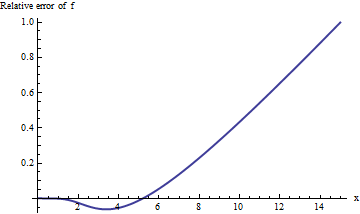The question concerns the complementary error function
$$\textrm{erfc}(x) = \frac{2}{\sqrt{\pi}}\int_{x}^{\infty}\exp(-t^2) d t$$
for "large" values of $x$ ($=n/\sqrt{2}$ in the original question)--that is, between 100 and 700,000 or so. (In practice, any value greater than about 6 should be considered "large," as we will see.) Note that because this will be used to compute p-values, there is little value in obtaining more than three significant (decimal) digits.
To begin, consider the approximation suggested by @Iterator,
$$f(x) = 1 - \sqrt{1 - \exp \left(-x^2 \left(\frac{4 + ax^2}{\pi + ax^2}\right)\right)},$$
where
$$a = \frac{8(\pi-3)}{3(4-\pi)} \approx 0.439862.$$
Although this is an excellent approximation to the error function itself, it's a terrible approximation to $\textrm{erfc}$. However, there is a way to systematically fix that up.
For the p-values associated with such large values of $x$, we're interested in the relative error $f(x)/\textrm{erfc}(x) - 1$: we hope its absolute value would be less than 0.001 for three significant digits of precision. Unfortunately this expression is difficult to study for large $x$ due to underflows in double-precision computation. Here is one attempt, which plots the relative error versus $x$ for $0 \le x \le 5.8$:

The calculation becomes unstable once $x$ exceeds 5.3 or so and cannot deliver one significant digit past 5.8. This is no surprise: $\exp(-5.8^2) \approx 10^{-14.6}$ is pushing the limits of double-precision arithmetic. Because there is no evidence that the relative error is going to be acceptably small for larger $x$, we need to do better.
Performing the calculation in extended arithmetic (with Mathematica) improves our picture of what's going on:

The error increases rapidly with $x$ and shows no signs of leveling off. Past $x=10$ or so, this approximation doesn't even deliver one reliable digit of information!
However, the plot is starting to look linear. We might guess that the relative error is directly proportional to $x$. (This makes sense on theoretical grounds: $\textrm{erfc}$ is manifestly an odd function and $f$ is manifestly even, so their ratio ought to be an odd function. Thus we would expect the relative error, if it increases, to behave like an odd power of $x$.) This leads us to study the relative error divided by $x$. Equivalently, I choose to examine $x \cdot \textrm{erfc}(x)/f(x)$, because the hope is this should have a constant limiting value. Here is its graph:

Our guess appears to be borne out: this ratio does seem to be approaching a limit around 8 or so. When asked, Mathematica will supply it:
a1 = Limit[x (Erfc[x]/f[x]), x -> \[Infinity]]
The value is $a_1 = \frac{2 }{\sqrt{\pi }}e^{\frac{3 (-4+\pi )^2}{8 (-3+\pi )}} \approx 7.94325$. This enables us to improve the estimate: we take
$$f_1(x) = f(x) \frac{a_1}{x}$$
as the first refinement of the approximation. When $x$ is really large--greater than a few thousand--this approximation is just fine. Because it's still not going to be good enough for an interesting range of arguments between $5.3$ and $2000$ or so, let's iterate the procedure. This time, the inverse relative error--specifically, the expression $1 - \textrm{erfc}(x)/f_1(x)$--should behave like $1/x^2$ for large $x$ (by virtue of the previous parity considerations). Accordingly, we multiply by $x^2$ and find the next limit:
a2 = Limit[x^2 (a1 - x (Erfc[x]/f[x])), x -> \[Infinity]]
The value is
$$a_2 = \frac{1}{32 \sqrt{\pi }} e^{\frac{3 (-4+\pi )^2}{8 (-3+\pi )}} \left(32-\frac{9 (-4+\pi )^3 \pi }{(-3+\pi )^2}\right) \approx 114.687.$$
This process can proceed as long as we like. I took it out one more step, finding
a3 = Limit[x^2 (a2 - x^2 (a1 - x (Erfc[x]/f[x]))), x -> \[Infinity]]
with value approximately 1623.67. (The full expression involves a degree-eight rational function of $\pi$ and is too long to be useful here.)
Unwinding these operations yields our final approximation
$$f_3(x) = f(x)\left(a_1 - a_2/x^2 + a_3/x^4\right)/x.$$
The error is proportional to $x^{-6}$. Of import is the constant of proportionality, so we plot $x^6(1 - \textrm{erfc}(x) / f_3(x))$:

It rapidly approaches a limiting value around 2660.59. Using the approximation $f_3$, we obtain estimates of $\textrm{erfc}(x)$ whose relative accuracy is better than $2661/x^6$ for all $x \gt 0$. Once $x$ exceeds 20 or so, we have our three significant digits (or far more, as $x$ gets larger). As a check, here is a table comparing the correct values to the approximation for $x$ between $10$ and $20$:
x Erfc Approximation
10 2.088*10^-45 2.094*10^-45
11 1.441*10^-54 1.443*10^-54
12 1.356*10^-64 1.357*10^-64
13 1.740*10^-75 1.741*10^-75
14 3.037*10^-87 3.038*10^-87
15 7.213*10^-100 7.215*10^-100
16 2.328*10^-113 2.329*10^-113
17 1.021*10^-127 1.021*10^-127
18 6.082*10^-143 6.083*10^-143
19 4.918*10^-159 4.918*10^-159
20 5.396*10^-176 5.396*10^-176
In fact, this approximation delivers at least two significant figures of precision for $x=8$ on, which is just about where pedestrian calculations (such as Excel's NormSDist function) peter out.
Finally, one might worry about our ability to compute the initial approximation $f$. However, that's not hard: when $x$ is large enough to cause underflows in the exponential, the square root is well approximated by half the exponential,
$$f(x) \approx \frac{1}{2} \exp \left(-x^2 \left(\frac{4 + ax^2}{\pi + ax^2}\right)\right).$$
Computing the logarithm of this (in base 10) is simple, and readily gives the desired result. For example, let $x=1000$. The common logarithm of this approximation is
$$\log_{10}(f(x)) \approx \left(-1000^2 \left(\frac{4 + a \cdot 1000^2}{\pi + a \cdot 1000^2}\right) - \log(2)\right) / \log(10) \sim -434295.63047.$$
Exponentiating yields
$$f(1000) \approx 2.34169 \cdot 10^{-434296}.$$
Applying the correction (in $f_3$) produces
$$\textrm{erfc}(1000) \approx 1.86003\ 70486\ 32328 \cdot 10^{-434298}.$$
Note that the correction reduces the original approximation by over 99% (and indeed, $a_1/x \approx 1\text{%}$.) (This approximation differs from the correct value only in the last digit. Another well-known approximation, $\exp(-x^2)/(x\sqrt{\pi})$, equals $1.860038 \cdot 10^{-434298}$, erring in the sixth significant digit. I'm sure we could improve that one, too, if we wanted, using the same techniques.)





